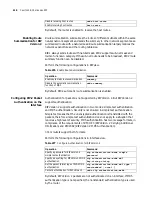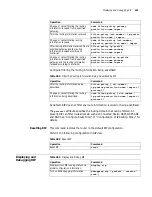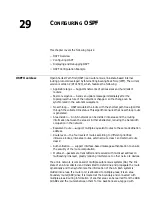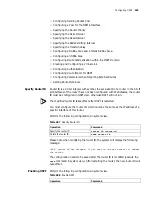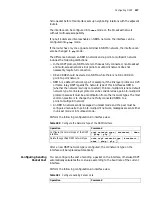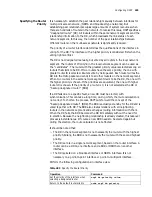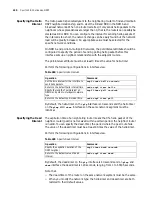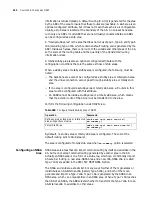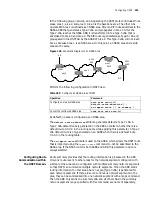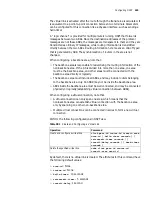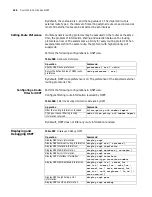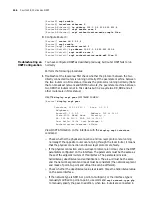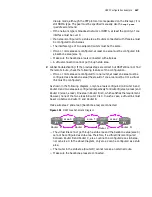
432
C
HAPTER
29: C
ONFIGURING
OSPF
information is reduced greatly. A default routing (0.0.0.0) is generated for the area
by the ABR of the area to insure that these routes are reachable. A stub area is an
optional configured attribute, but it does not mean that each area is configurable.
Usually, a stub area is located at the boundary of the AS. A non-backbone area
with only one ABR or multi-ABR that are not virtually connected between ABRs
can be configured as a stub area.
A “totally stubby area” is the area that does not receive Type-3, Type-4, and Type-5
LSA (excluding Type-3 LSA which contains default routing and is generated by the
ABR). Inside such areas, there is no route to the outside and other areas of the AS,
so the scale of the routing table and the quantity of the transmitted routing
information is less.
A totally stubby area is also an optional configured attribute with the
configuration conditions that are the same as those of stub areas.
When a stubby area or totally stubby area is configured, the following must be
noted:
■
The backbone area cannot be configured as a stubby area or totally stub area
and the virtual connection cannot pass through a stubby area or totally stub
area.
■
If one area is configured as stubby area or totally stub area, all routers in this
area must be configured with this attribute.
■
An ASBR cannot be inside a stubby area or a totally stub area, which means
that the exterior route of the AS cannot be transferred to the area.
Perform the following configuration under OSPF view:
Table 498
Configure Totally Stubby Area of OSPF
By default, no stubby area or totally stub area is configured. The cost of the
default routing sent to Stub area is 1.
The area is configured of totally stub area when
no-summary
option is selected
Configuring an NSSA
Area
NSSA areas are areas that can import external routing by itself and advertise in the
AS, but cannot accept external routing generated by another area in the AS.
Actually an NSSA area is one form of a stub area, which can conditionally import
AS external routing. A new area-NSSA Area and a new LSA-NSSA LSA (or called
Type-7 LSA) are added in the RFC1587 OSPF NSSA Option.
The NSSA and stub area are similar in many ways. Neither of them generates or
redistributes an AS-External-LSA (namely Type-5 LSA), and both of them can
generate and import a Type-7 LSA. Type-7 LSA is generated by the ASBR in an
NSSA area, which can only advertise in an NSSA area. When a Type-7 LSA reaches
the ABR of an NSSA, the ABR selects whether to transform the Type-7 LSA into an
AS-External-LSA to advertise to other areas.
Operation
Command
Define an area as stub area or totally stub
area and specify cost value.
stub cost
cost
area
area-id
[
no-summary ]
Cancel Stub Area
undo stub cost
cost
area
area-id
[
no-summary ]
Summary of Contents for Router 3032
Page 1: ...http www 3com com 3Com Router Configuration Guide Published March 2004 Part No 10014299...
Page 4: ...VPN 615 RELIABILITY 665 QOS 681 DIAL UP 721...
Page 6: ...2 ABOUT THIS GUIDE...
Page 7: ...I GETTING STARTED Chapter 1 3Com Router Introduction Chapter 2 3Com Router User Interface...
Page 8: ...4...
Page 16: ...12 CHAPTER 1 3COM ROUTER INTRODUCTION...
Page 34: ...30...
Page 60: ...56 CHAPTER 3 SYSTEM MANAGEMENT...
Page 98: ...94 CHAPTER 6 DISPLAY AND DEBUGGING TOOLS...
Page 110: ...106...
Page 114: ...110 CHAPTER 8 INTERFACE CONFIGURATION OVERVIEW...
Page 158: ...154 CHAPTER 10 CONFIGURING WAN INTERFACE...
Page 168: ...164...
Page 188: ...184 CHAPTER 13 CONFIGURING PPPOE CLIENT...
Page 192: ...188 CHAPTER 14 CONFIGURING SLIP Router ip route static 0 0 0 0 0 0 0 0 10 110 0 1...
Page 248: ...244 CHAPTER 16 CONFIGURING LAPB AND X 25...
Page 320: ...316...
Page 330: ...326 CHAPTER 20 CONFIGURING IP ADDRESS...
Page 362: ...358 CHAPTER 21 CONFIGURING IP APPLICATION...
Page 374: ...370 CHAPTER 23 CONFIGURING IP COUNT...
Page 406: ...402 CHAPTER 25 CONFIGURING DLSW...
Page 408: ...404...
Page 452: ...448 CHAPTER 29 CONFIGURING OSPF...
Page 482: ...478 CHAPTER 30 CONFIGURING BGP...
Page 494: ...490 CHAPTER 31 CONFIGURING IP ROUTING POLICY...
Page 502: ...498...
Page 508: ...504 CHAPTER 33 IP MULTICAST...
Page 514: ...510 CHAPTER 34 CONFIGURING IGMP...
Page 526: ...522 CHAPTER 36 CONFIGURING PIM SM...
Page 528: ...524...
Page 532: ...528 CHAPTER 37 CONFIGURING TERMINAL ACCESS SECURITY...
Page 550: ...546 CHAPTER 38 CONFIGURING AAA AND RADIUS PROTOCOL...
Page 590: ...586 CHAPTER 40 CONFIGURING IPSEC...
Page 599: ...IX VPN Chapter 42 Configuring VPN Chapter 43 Configuring L2TP Chapter 44 Configuring GRE...
Page 600: ...596...
Page 638: ...634 CHAPTER 43 CONFIGURING L2TP...
Page 649: ...X RELIABILITY Chapter 45 Configuring a Standby Center Chapter 46 Configuring VRRP...
Page 650: ...646...
Page 666: ...662...
Page 670: ...666 CHAPTER 47 QOS OVERVIEW...
Page 700: ...696 CHAPTER 49 CONGESTION MANAGEMENT...
Page 706: ...702 CHAPTER 50 CONGESTION AVOIDANCE...
Page 707: ...XII DIAL UP Chapter 51 Configuring DCC Chapter 52 Configuring Modem...
Page 708: ...704...
Page 762: ...758 CHAPTER 52 CONFIGURING MODEM...

